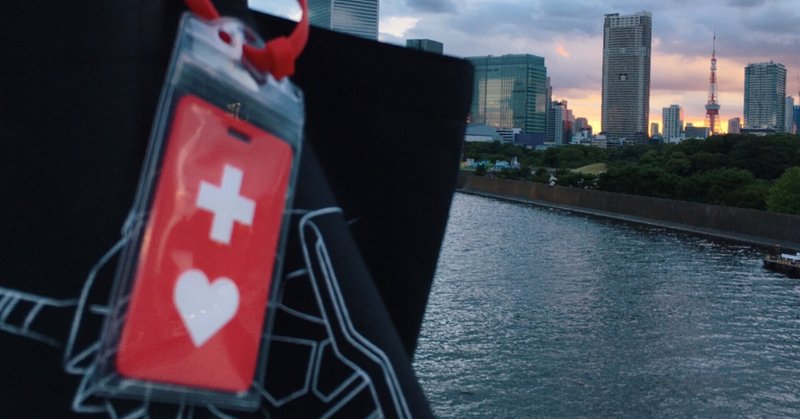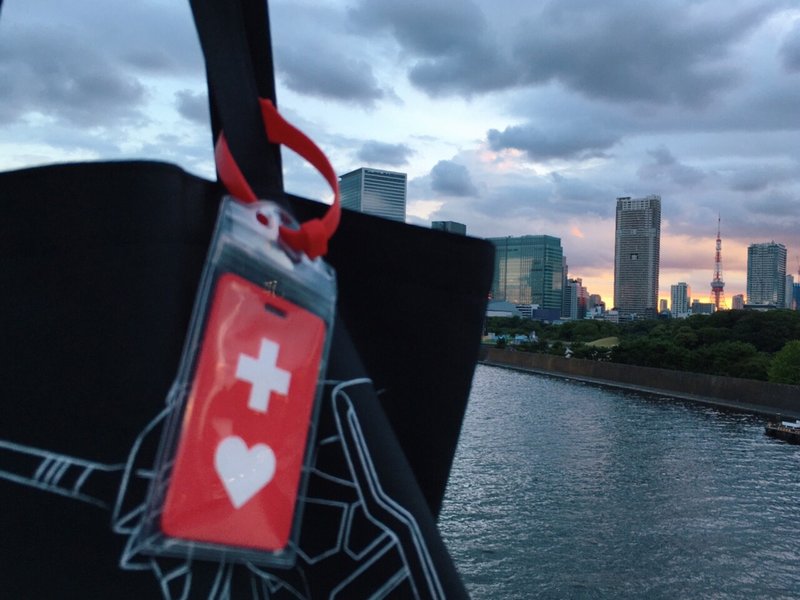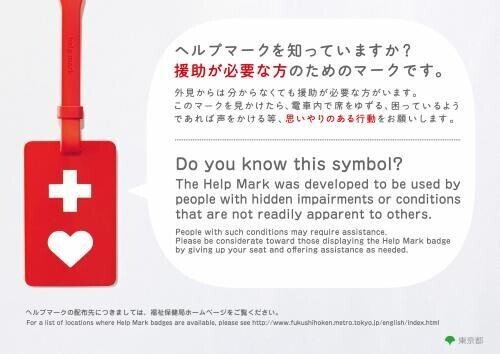
The “Help Mark” makes invisible health conditions visible
Some disabilities and health conditions are not visible. Examples include prosthetic legs and joints, internal health issues, rare or serious illnesses, and early stages of pregnancy. They might have difficulty hearing, communicating, holding the handrail, standing up from a seated position, staying in a standing position, walking up and down stairs, or responding in the event of an accident or disaster.
However, since people with these conditions may not be seen in wheelchairs, walking with canes, or using other “visible” devices or aids, they may go unnoticed or be misunderstood. They may also not receive the help that they need when they’re in public.
In 2012, the Tokyo Metropolitan Government created the “Help Mark,” which has a white cross and a heart, to indicate that they have disabilities or health conditions, and make it easier for them to receive help from others.
When you see people wearing a tag with this mark on their bags, please offer your help as needed: offering your seat on trains and buses, assisting them when there are unexpected events, helping them walk up and down the stairs, assisting them in evacuating or going to a safe location, or asking how you can help. The tag has a label on the back, where people can write their condition and indicate what help they need.
While the tag is meant to help raise awareness of people suffering from invisible conditions, awareness of the “Help Mark” remains low. Some people might look just like any other person, so they might be disregarded and even misunderstood. Some even suffer from stigma.
These are some of the comments I’ve heard regarding the tag:
- “I thought it was a luggage tag with a cute design.”
- “My son has a developmental disability, and wears a tag on his bag. Some children make fun of him. One parent said to her child, ‘Don’t go near him. He must be crazy,’ and used a harmful word that refers to people with mental illnesses.”
- “It looks like a quiet demand, pressuring people to give up their seats.”
I sincerely hope that this article would help raise awareness, break down social barriers for people with invisible disabilities and conditions, and promote understanding and an inclusive society.
(370 words) Written by Maya
Copyright of the above image is owned by the Tokyo Metropolitan Government Bureau of Social Welfare and Public Health.
Resources:
ヘルプマーク (東京都福祉保健局)
https://www.fukushihoken.metro.tokyo.lg.jp/shougai/shougai_shisaku/helpmark.html
ヘルプマーク紹介リーフレット
https://www.fukushihoken.metro.tokyo.lg.jp/shougai/shougai_shisaku/helpmark.files/TOKYO_Helpmark_CCJMD6.pdf
“Do you know about the Help Mark? (Bureau of Social Welfare and Public Health, Tokyo Metropolitan Government)
https://www.fukushihoken.metro.tokyo.lg.jp/helpmarkforcompany/multilingual/en.html
知っていますか?街の中のバリアフリーと「心のバリアフリー」
https://www.gov-online.go.jp/useful/article/201812/1.html
Accessibility Resources:
Tokyo Accessibility Information (NPO Live With Dream)
東京バリアフリーマップ (NPO法人リーブ・ウィズ・ドリーム)
https://www.lwd.tokyo/
Accessible Japan
https://www.accessible-japan.com/

この記事が気に入ったらサポートをしてみませんか?

